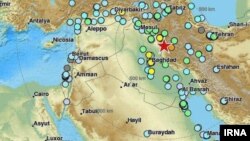Tasnim and Mehr news agencies say at least 348 people have been killed and emergency services report that the number of those injured could reach as high as 6,000 in a devastating earthquake near the Iran-Iraq border.
Iran’s Interior Ministry said earlier on November 13 that most of the casualties were in Kermanshah Province, with residents reporting feeling the 7.3 magnitude quake throughout the region, from Turkey to Kuwait.
The U.S. Geological Survey said it was centered 19 miles (32 kilometers) southwest of the city of Halabja in northeastern Iraq at a depth of 33.9 kilometers (21 miles).
Tehran University’s seismological center said the temblor hit at 9:48 p.m. local time (1818 GMT) on November 12.
Iran's official IRNA news agency quoted officials as warning that the casualty toll was expected to rise as emergency workers began work at first light on November 13.
As rescue work continues, IRNA reports that badly damaged areas face shortages of medication and equipment.
A member of parliament told reporters that some of the newly built hospitals in the area have been destroyed in the earthquake. Similar reports speak of more severe damage to public housing built in the last ten years.
In Iraq, Kurdish health officials said at least six people were killed and at least 68 injured. Iraq's health and local officials said the worst-hit area was Darbandikham district, near the border with Iran, where at least 10 houses had collapsed and the district's only hospital was severely damaged.
Prime Minister Haider al-Abadi issued a written statement re-assuring people and announcing that the government has dispatched civil defense teams to the earthquake areas.
Iran's Supreme Leader, ayatollah Ali Khamenei and President Hassan Rouhani issued orders for providing every possible assistance to rescue work and treating the injured.
Officials said the Iranian border town of Ghasre Shirin was heavily damaged, with rescue workers reporting that their efforts were being made difficult because of power outages.
The regional governor's office said helicopters and sniffer dogs were in place but could only start operations at first light on November 13.
Mojtaba Nikkerdar, the provincial deputy governor in Iran's western Kermanshah Province, told state television there were deaths in at least 30 separate villages, but he said it would take hours before exact casualty numbers could be determined.
"There are still people under the rubble. We hope the number of dead and injured won't rise too much, but it will rise," Nikkerdar said.
Reports said most of the Iranian dead were in Kermanshah Province. The town of Sarpol-e Zahab, about 15 kilometers from the Iraq border, was one of the hardest hit, with dozens of people killed, the reports said.
The semiofficial Iranian ILNA news agency reported that at least 14 provinces had been affected by the earthquake.
"The quake was felt in several Iranian provinces bordering Iraq...Eight villages were damaged...Electricity has been cut in some villages and rescue teams have been dispatched to those areas," state TV reported.
IRNA said water and electricity had been cut in some parts of Kermanshah Province.
News agency reported that Iranian President Hassan Rouhani called on the Interior Ministry to make a maximum effort to aid victims.
Iraqi news agencies showed photos of crumbled buildings in around the city of Sulaimaniya in Kurdistan, saying at least 50 people had been injured in Darbandikhan town.
The quake was also felt in the Iranian capital of Tehran and in the Iraqi capital, Baghdad.
Residents of southwest Turkey, Israel, and Kuwait also said they had felt the temblor.
Iran is on many major fault lines and is often hit by damaging earthquakes. In 2003, a 6.6-magnitude quake destroyed the historic city of Bam, killing 26,000 people.




